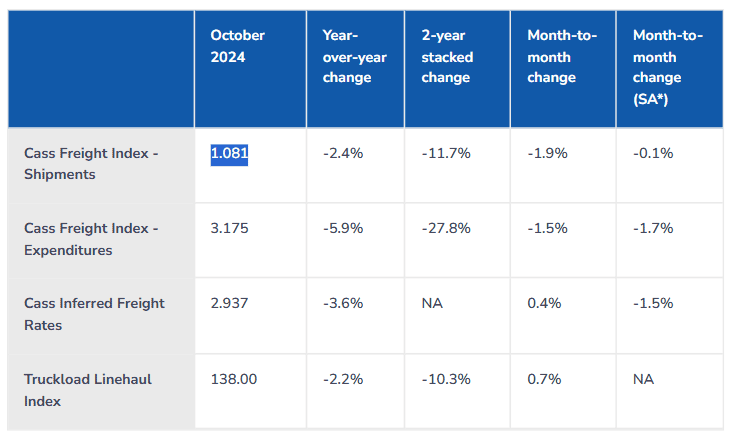It’s been tough times in the US freight sector for more than two years, and the news is only getting slightly better for carriers, even as shippers benefit from the continued fall in rates.
Supply Chain Digest Says...
|
 |
| He adds that private fleets may be realizing how much cost they’re leaving on the table. Denoyer estimates at least $1 per mile savings with for-hire contract rates compared to private fleet costs, which is more than double the long-term average. |
 |
What do you say? |
| Click here to send us your comments |
 |
| |
|
The Cass Freight Report for October was released late last week and it showed shipment volumes were downmodestly versus September, while rates were mixed.
The monthly report from Cass and partner Tim Denoyer of ACT Research is based on data from the billions of dollars of freight bills that Cass pays for its shipper clients.
The Cass shipments index, which covers several modes but is weighed towards full truckload, was basically flat in October versus September in seasonally adjusted (SA) terms, falling just 0.1%. Non-seasonally adjusted, the Index was down 1.9%.
However, shipments declined by 2.4% versus 2023 in October after a 5.2% drop in September.
Since Q2, Denoyer has identified a trend weighing on freight volumes for carriers: For-hire fleets likely are seeing soft demand because of significant private fleet capacity additions in the past couple of years. That has led many private fleets to now more actively compete for spot freight to fill empty backhauls.
In the October report, Denoyer says that “In a sign that private fleet growth continues to affect for-hire demand, the ongoing softness in shipments comes as Class 8 tractor sales rebounded from supply constraints in Q2,” adding that “Although goods demand growth is driving broad freight volume growth, as can be seen in intermodal, imports, and freight GDP, it is still not reaching the for-hire market.
After rising 13% in 2021 and 0.6% in 2022, the Shipping Index declined 5.5% in 2023. With normal seasonality, the index will fall about 3% year-over-year in November and about 4% for the full year.
The expenditures component of the Cass Freight Index, which measures the total amount spent on freight, fell 1.5% month-over-month in October, partly due to another decline in fuel prices. The year-over-year decline was a sharp 5.9% versus 6.6% in September.
With shipments down 1.9% and expenditures falling less, at -1.5%, it implies a modest increase in rates.
Another look at rates comes from the Cass Linehaul Index, which measures US per mile truckload rates before fuel surcharge and other accessorials.
In October, the index was down 2.2% versus 2023, narrowing the gap over a number of months now. Cass says the delta could turn positive in early 2025.
In some interesting concluding comments, Denoyer observes that “As private fleet growth is slowing, it’s worth highlighting the significant capacity contraction by for-hire fleets. In Q3, we estimate the publicly traded fleets were 5.9% smaller than a year ago. While the sequential decline in tractor count slowed, the current low-margin environment is not motivating investment.”
(See More Below)
He adds that private fleets may be realizing how much cost they’re leaving on the table. Denoyer estimates at least $1 per mile savings with for-hire contract rates compared to private fleet costs, which is more than double the long-term average.
Each month, Cass nicely summarizes the state of freight, as seen in the graphic below for October:

Source: Cass
Any thoughts on the Cass report? Let us know your thoughts at the Feedback section below.
|